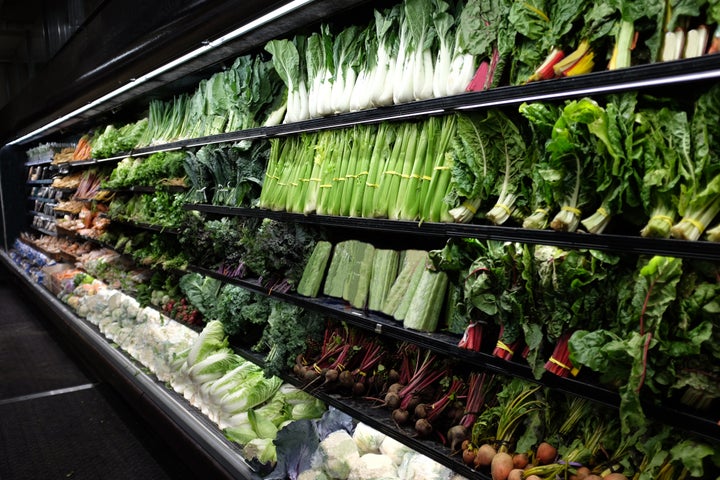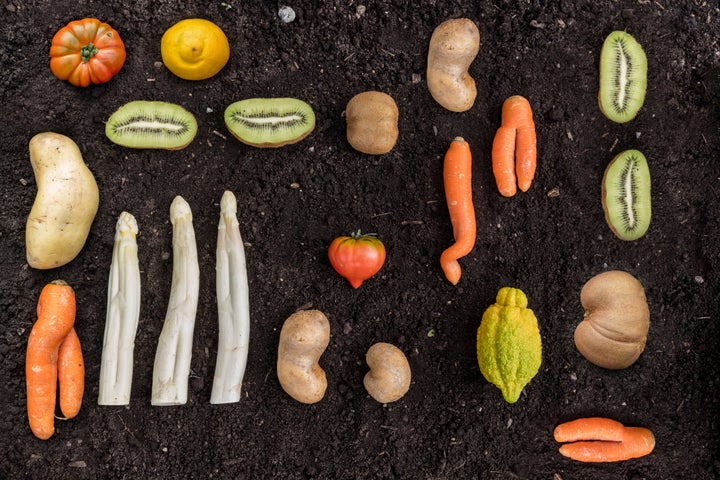Well-presented, shiny and uniformly sized apples, carrots and other fruits and vegetables are what we’ve come to expect in our local grocery store.
But it’s a perfection that does not always reflect the produce being grown on farms across the U.S., says Danielle Nierenberg, co-founder of the nongovernmental organization Food Tank.
“Food grows in the soil and is dirty and comes in all shapes and sizes, yet we’ve been trained to believe that everything is pristine and perfect. It’s part of our culture now. The grocery aisles tell our eyes one thing and we don’t realize that there is nothing bad about misshapen or imperfect-looking food.”
And many of us associate aesthetics with eating pleasure. “People think food that looks perfect tastes perfect, but that’s not the case. Ugly can be tasty and nutritious,” Nierenberg says.
It all started with the spread of refrigeration technology in the 1980s that enabled fresh fruits and vegetables to be kept chilled soon after being harvested all the way through to the grocery aisle. The ability to preserve “perfect-looking” produce over longer distances gave retailers the option to source fresh produce from further afield and so be more selective about what they would take, enabling them to set increasingly stringent quality standards.
“The result is that if you go to a grocery store in the U.S. today, you see aisles of apples all the same shape and color. It teaches kids that this is what fruit and vegetables are meant to look like,” says Evan Lutz, co-founder of the food waste company Hungry Harvest.
That culture is being reinforced by social media and the focus on immaculate, Instagram- and Pinterest-worthy meals, says Andrea Spacht, a food specialist at the Natural Resources Defense Council.

The downside to this desire for perfect fruits and vegetables is mountains of food waste.
A study in Minnesota found that up to 20 percent of most fruit and vegetable crops were too large, too small or otherwise too cosmetically compromised to meet the standards set by retail buyers, with some growers reporting losses up to 30 percent or higher. Another study in North Carolina found 42 percent of crops were left unharvested, the majority of which did not meet appearance quality standards set by buyers.
Farmers have also said they have been forced to leave crops unharvested because the prices offered by buyers for lower-quality fruit and vegetables is too low to cover the costs of harvesting, including transport and labor.
“If the price being offered by the market is too low, then sometimes the produce just sits unharvested in the field,” says Sam Thorp, who runs the fruit and vegetable farm Spade & Plow in San Martin, California.
“Retailers have realized that if fresh produce looks a certain way, it will sell better. Therefore, knowing what they are going to get from farmers is important to them, hence why they set those quality standards,” he adds.
Thorp has seen such waste firsthand, having worked on a number of farms. But after setting up his own farm business with his father, Mike, and brother Nick in 2015, they have managed to cut waste by selling not just to wholesale buyers but directly to customers.
Just this past month, a period of cold weather left the Thorps with a harvest full of blistered artichokes that they could not sell to wholesale buyers. But the local restaurants the farm sells to were more than happy to buy the artichokes, as were the farm’s veg box customers and those they sell to at farmers markets.
They might not look perfect, but the blemished artichokes taste just fine, says Thorp: “They actually taste even better as they’re a little bit sweeter and nuttier.”

Making consumers realize that ugly fruit and vegetables still taste good and are fine to eat could help significantly cut food waste, says Nierenberg. And that message doesn’t only have to come from farmers.
Spacht says there are positive signs out there of our perfection culture being challenged with TV shows such as A&E’s “Scraps,” which features chef Joel Gamoran making beautiful food with an eye toward preventing waste.
There are also a number of companies that claim to be helping reduce food waste by selling excess produce, including ugly fruit and vegetables, to consumers via doorstep delivery programs. One of those is Baltimore-based Hungry Harvest, which buys surplus food ― including fruit and vegetables that don’t meet quality standards ― from growers and wholesalers, and sells it to consumers via box subscriptions.
Critics have argued that companies like Hungry Harvest are just creating a premium market for food that would otherwise be sold for food processing or given to food banks ― and not wasted.
But Lutz told HuffPost that Hungry Harvest is “not an ugly veg company” and that this only accounts for a small proportion of the produce they buy. The majority is just surplus to requirements because, for example, the farmer could not find a buyer for it. “What we sell is a full range of what farms produce [rather than just the perfect food]. We want people to accept food as it is.”
While the debate around ugly fruits and vegetables gains attention, it’s important to remember that wonky produce is far from the only source of food waste. A bigger problem is food wasted at home. More than 50 percent of the food that ends up in landfills in the U.S. originates from consumers.
Tackling this requires consumers to watch portion sizes and find ways to make use of foods that often get thrown out, says Nierenberg.
California-based charity Food Forward is one organization trying to tackle this. In addition to distributing unsold fruits and vegetables from wholesalers and farmers to local food banks, it runs food waste education programs in local schools, teaching students how to use foods that often get thrown out at home, such as brown bananas to make banana bread.
Ultimately, getting people to cut their food waste may come down to government action. In South Korea, a national ban on sending food to landfills and a legal requirement for residents to pay for what they throw away has led to a reduction in the amount of food wasted in people’s homes.
“It makes you aware of how much waste you’re producing,” one South Korean resident told HuffPost. Pretty much all of what is discarded is recycled into animal feed, fertilizer, biogas or bio-oil.
For Thorp, there is a much easier solution for any fruits and vegetables they have left over once they’ve sold as much ugly produce as they can. “We have a neighbor who keeps goats,” he says.
For more content and to be part of the “This New World” community, follow our Facebook page.
HuffPost’s “This New World” series is funded by Partners for a New Economy and the Kendeda Fund. All content is editorially independent, with no influence or input from the foundations. If you have an idea or tip for the editorial series, send an email to thisnewworld@huffpost.com

